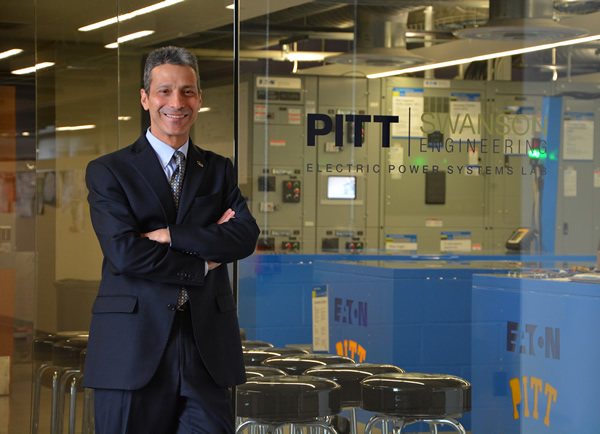
Pittsburgh
Microgrid technology is set to play a big role in the continued revitalization of the rust-belt city of Pittsburgh, according to Dr. Gregory Reed, professor of engineering at the Electrical & Computer Engineering Department in the Swanson School of Engineering at the University of Pittsburgh.
Reed is also the Director of the Pitt Center for Energy and the Grid Institute, as well as the Electric Power Systems Laboratory. And HOMER Pro™ is playing a small, but crucial, part in that transformation.
Once famous for its heavy industry and noxious pollution, the former steel town is aiming to become a leader in the clean tech economy. Since Pittsburgh has always been a nexus for engineering and technology expertise, they may well succeed. As a small city, it’s well suited for innovation: large enough to face the same issues as the bigger cities of the world, but still small enough to implement positive changes and model them for other communities.
Dr. Reed, who appears to have a hand in many of the interesting changes that are afoot in Pittsburgh’s planned energy transformation says, “Listen. Pittsburgh used to be this smoke belching industrial center. We’re going to turn that legacy around and become one of the cleanest cities in the modern world. If we can do it, anybody can.”
City Energy Districts to Showcase Energy Advances
Reed is one of the architects of “energy districts” in Pittsburgh, neighborhoods that are the focus of energy innovation projects. While some of these districts have steam-based legacy district heating plants, other neighborhoods will lend themselves to renewable energy via microgrids and grid-tied distributed energy resource systems. Reed says that instead of energy districts, he prefers to call the proposed new energy infrastructure a “grid of microgrids.” He adds, “I look at this as part of the new economy, creating jobs in the clean-tech and energy sectors, fighting climate change.”
The genesis of Pittsburgh’s interest in microgrids was about five years ago when the city began considering ambitious climate goals. Now, Pittsburgh is aiming for an 80% reduction in greenhouse gas emissions by 2050, and proposes that the city government will run 100% on renewable energy by 2030.
Resilient Cities Plan Distributed Energy Resources
Meanwhile, in 2014, Pittsburgh joined a network of “100 Resilient Cities” sponsored by the Rockefeller Foundation. As an inland city, Pittsburgh isn’t particularly susceptible to the types of extreme weather events that have devastated coastal cities in recent decades. But perched on steep hills carved out by the confluence of the Allegheny, Monongahela and Ohio rivers, and laced with an aging network of bridges, tunnels and water management infrastructure, the city is at risk for dangerous flooding.
How can Pittsburgh achieve its challenging new sustainability goals while simultaneously renovating its aging infrastructure, modernizing, upgrading, and becoming more resilient, not to mention more inclusive and economically just? It turns out that resilience can provide a useful framework for urban planning, aligning disparate goals, and encouraging diverse stakeholders to collaborate.
The city, led by its new Rockefeller-funded “sustainability officer” Grant Ervin, dozens of stakeholders (including Dr. Reed and his team of colleagues and eager engineering students), and the region’s generous philanthropists set about creating a strategy to achieve their goals. It turns out that one key pillar of the city’s new strategy is developing a “resilient energy portfolio through diversified resources and local generation.”

Dr. Greg Reed, University of Pittsburgh
HOMER Pro Helps Design Pittsburgh Microgrids
Explaining that many of his engineering students are using HOMER Pro to assist on diverse client projects, Dr. Reed says “We are working on about 20 energy projects across the city. We use HOMER Pro in two important ways: First we use it in initial feasibility studies to get an idea of what the energy profile of a site or proposed microgrid might look like. The software helps us put together early-stage financial estimates. Then we use the HOMER Optimizer™️ to inform the detailed design, as well as information on carbon emissions tradeoffs. We can put in specific types of technology and vendors, and compare the ROI and long-term operating costs, along with a projected emissions report.”
Reed says that among the 20 energy projects being considered in Pittsburgh, some neighborhoods will always remain tied to the grid, but benefit from adding distributed renewable energy. Other neighborhoods might benefit from microgrid infrastructure, which means they would be able to operate independent of the main electric grid if need be. That includes universities, medical centers, brownfield areas, and corporate campuses.
One such corporate campus is the 21-acre Woods Run facility owned by the Duquesne Light Company, Pittsburgh’s resident electric utility, which currently provides power to over 620,000 customers. Duquesne wants to study how hybrid microgrids perform, and learn how to use them to integrate more renewable energy in their power system. That’s something Duquesne customers have been clamoring for. The Woods Run Microgrid project will include three 800 kW natural gas generators, two 100 kW solar arrays, a wind turbine, and three utility-scale battery installations. However, before the project can be launched, the Pennsylvania Public Utility Commission may need to weigh in if Duquesne wants to make any of that power available to its customers. Since Pennsylvania is a deregulated state, utilities are not allowed to own generation assets; a special exception might need to be made for the Woods Run Microgrid.
A New Electric Grid Study Center for Pittsburgh
Another microgrid is on the drawing boards for Pittsburgh’s Hill District neighborhood, of Hill Street Blues fame. One of Reed’s projects, the Pitt Energy Grid Institute, is slated to be a national center for the study of electric grids. The GRID Institute is currently under construction in a renovated 1930s era trade school, and will include a high-energy, high capacity laboratory and center for energy business innovation. Equipped with a 15 kV, 5 MW AC capacity grid system, and a 1.5 kV, 1 MVA DC system, the lab will also have a natural gas tie-in. It will be connected to the local electric grid owned by Duquesne Light through a dedicated feed and includes plans for solar PV and micro-wind turbine facilities. Once a thriving black neighborhood of homes and businesses, the Hill District has been decimated by decades of ill-conceived“urban renewal” projects dating back to the 1950s. Reed hopes that locating the Energy Grid Institute there could help in revitalization efforts for the neighborhood and serve as an anchor for community development.
Reed says his group is also using HOMER Pro to develop proposals for Pittsburgh’s legacy steel and manufacturing industries. “What I love about HOMER,” he says “is not just that you can put in solar and CHP or other components, but you can tell HOMER to optimize for specific factors like carbon emissions. You’d be surprised how important this is to many companies, and how impressed they are when they see the potential to reduce their carbon footprint. The kind of detailed analysis we can do with HOMER Is really having an impact on them.”
